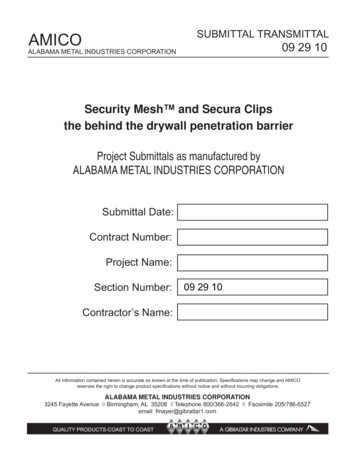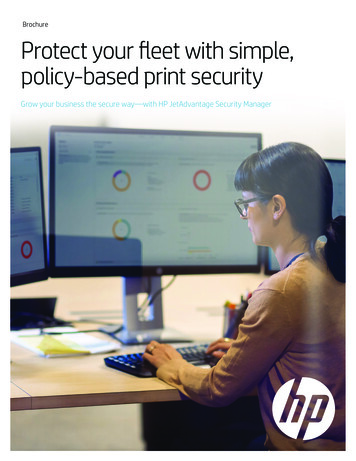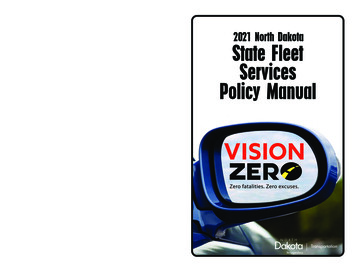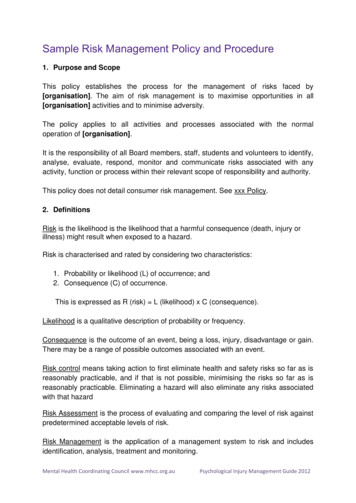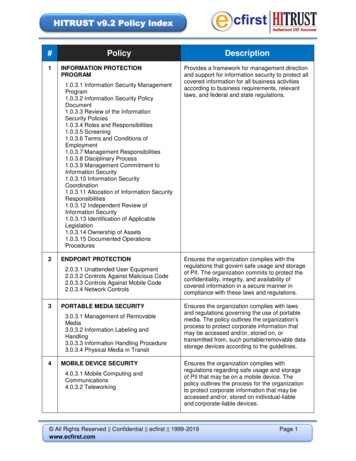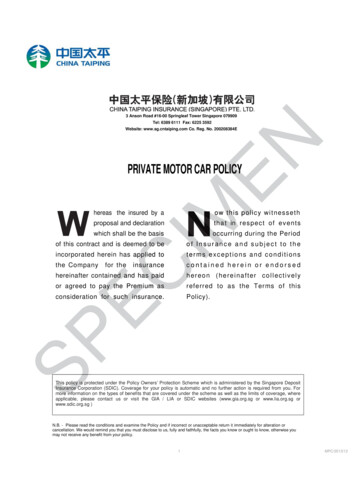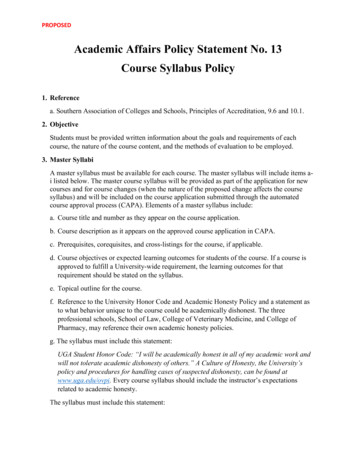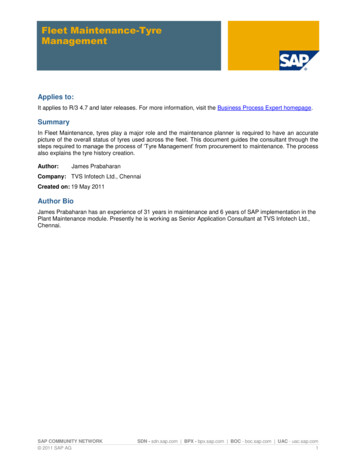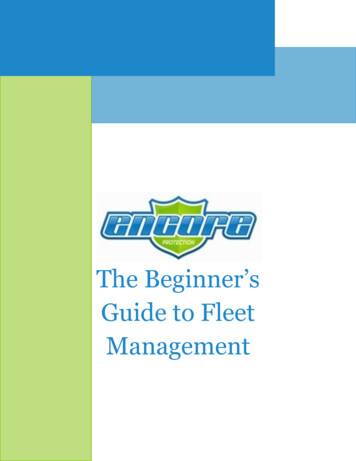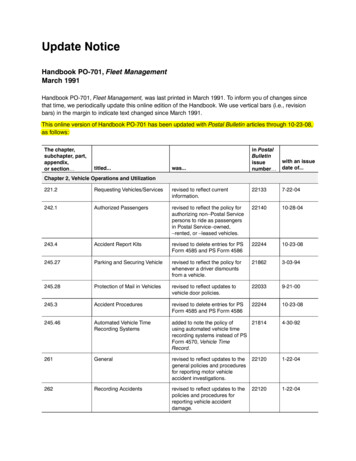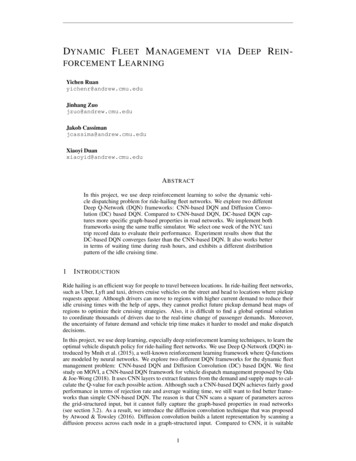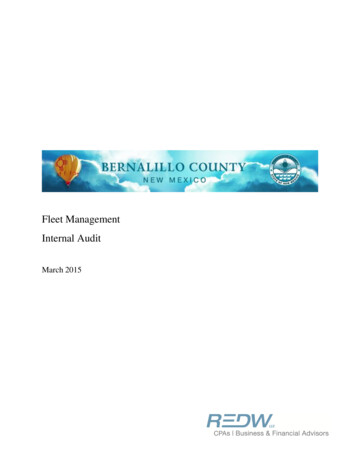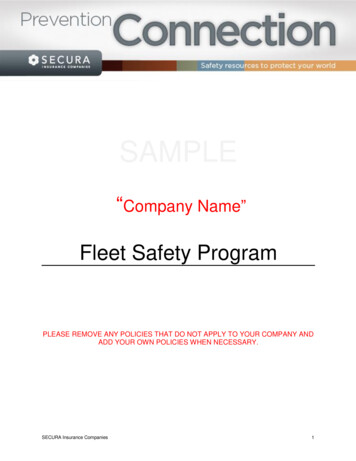
Transcription
SAMPLE“Company Name”Fleet Safety ProgramPLEASE REMOVE ANY POLICIES THAT DO NOT APPLY TO YOUR COMPANY ANDADD YOUR OWN POLICIES WHEN NECESSARY.SECURA Insurance Companies1
FLEET MANAGEMENT POLICYTable of ContentsI.Motor Vehicle Safety PolicyII.Organization and ResponsibilitiesIII.Vehicle UseIV.Driver SelectionV.Accident Recordkeeping, Reporting and AnalysisVI.Employee Accident Reporting ProcedureVII.Company Accident Review BoardVIII.Vehicle Selection, Inspection, and MaintenanceIX.Driver TrainingX.Driver Safety RegulationsXI.APPENDIX Vehicle Assignment Agreement Application Addendum for Employment Requiring Driving Guide for Preventable and Nonpreventable Accidents Vehicle Inspection Report DOT ComplianceSECURA Insurance Companies2
MOTOR VEHICLE SAFETY POLICY1.PolicyMany employees operate company-owned, leased, rental, or personal vehiclesas part of their jobs. Employees are expected to operate vehicles safely toprevent accidents that may result in injuries and property loss. It is the policy ofCOMPANY NAME HERE to provide and maintain a safe working environment toprotect our employees and the citizens of the communities where we conductbusiness from injury and property loss. The company considers the use ofautomobiles part of the working environment. The company is committed topromoting a heightened level of safety awareness and responsible drivingbehavior in its employees. Our efforts and the commitment of employees willprevent vehicle accidents and reduce personal injury and property loss claims.This program requires the full cooperation of each driver to operate their vehiclesafely and to adhere to the responsibilities outlined in the Motor Vehicle SafetyProgram. Elements of this program include: 2.Assigning responsibilities at all levels of employment.Vehicle use and insurance requirements.Employee drivers license checks and identification of high-risk drivers.Accident reporting and investigation.Company Accident Review Board.Vehicle selection and maintenance.Training standards.Safety regulations.ResponsibilityManagement is responsible for successful implementation and on-goingexecution of this program. Supervisors and employees are responsible formeeting and maintaining the standards set forth in this program.3.ScopeThis policy applies to employees who operate vehicles on company business andwill be reviewed by managers and supervisors to ensure full implementation andcompliance.SignedSECURA Insurance CompaniesDate3
ORGANIZATION AND RESPONSIBILITIES1.Company President: PLACE NAME HEREThe company president is responsible for directing an aggressive vehiclesafety program.2.Management will:A. Implement the Motor Vehicle Safety Program in their areas of responsibility.B. Establish measurement objectives to ensure compliance with the program.C. Provide assistance and the resources necessary to implement and maintainthe program.3.Supervisors will:A. Investigate and report all accidents involving a motor vehicle used in performingcompany business. Forward all accident reports to the Vehicle SafetyCoordinator – PLACE NAME HERE.B. Be responsible for taking appropriate action to manage high-risk drivers asdefined by this program.C. Provide driver training either internally or through external means for highrisk drivers.4.Vehicle Safety Coordinator: PLACE NAME HEREA. Issue periodic reports of losses for the president's review.B. Review motor vehicle accident reports as part of the Company Accident ReviewBoard. REMOVE IF YOU WILL NOT HAVE AN ACCIDENT REVIEW BOARDC. Revise and distribute changes to the Motor Vehicle Safety Program to managers,supervisors, and drivers as necessary.D. Maintain appropriate records.5.Drivers will:A. Always operate a motor vehicle in a safe manner as explained under the sectiontitled "Driver Safety Regulations."B. Maintain a valid driver's license and minimum insurance requirements onpersonal vehicles used in company business.C. Maintain assigned vehicles according to established maintenance standards.SECURA Insurance Companies4
VEHICLE USE1.Company Owned VehiclesA. Passenger CarsEmployees authorized by their supervisors will be permitted to operate apassenger car. When the vehicle is driven for personal use, only the employee orthe employee's spouse will be permitted to operate the vehicle. No one under theage of 21 will be permitted to operate the vehicle.B. Commercial Vans and TrucksEmployees with appropriate commercial driver's license (if required by the state),authorization from their supervisor and qualified by state and Federal DOT whenapplicable will be permitted to operate the vehicle.2.Personal Vehicles on Company BusinessA. Employees who drive their personal vehicles on company business are subject tothe requirements of this program including:1. Maintaining auto liability insurance with minimum limits of forbodily injury and for property damage with combined single limitof .2. Maintain current state vehicle inspections when required.3. Maintain their own vehicle in a safe operating condition when driven oncompany business.3.Rental VehiclesA. Rental vehicles will be leased from (INDICATE VENDORS SUCH AS HERTZ,AVIS, ETC.).B. Collision damage waiver will be refused.4.Unauthorized Use of VehiclesAssigned drivers and other authorized employees will not allow an unauthorizedindividual to operate a company vehicle. No exceptions! Disciplinary action maybe taken. Additionally, if unauthorized use results in an accident, the responsibleemployee will be required to make restitution for the damages.5.Contractors and Temporary EmployeesContractors and temporary employees will be treated as company employeesand will comply with the requirements of this program. Failure to meet allrequirements will result in the immediate loss of driving privileges.SECURA Insurance Companies5
DRIVER SELECTION1.Driver Evaluation:Employees will be evaluated and selected based on their driving ability. Toevaluate employees as drivers, management will:A. Review past driving performance and work experience through previousemployer’s reference checks. All new employees and current employeesrecently assigned to driving duties will be required to complete the "ApplicationAddendum for Employment Requiring Driving."B. Review the employee's Motor Vehicle Record (MVR) annually (morefrequently if reasons warrant).C. Ensure the employee has a valid driver's license.D. Ensure the employee is qualified to operate the type of vehicle he/shewill drive.2.Driver Qualification:Effective driver qualification controls are important elements of a successfulmotor vehicle safety program. Management developed and incorporatedstandards into this program which reflect the skills necessary for satisfactory jobperformance, while taking into consideration applicable federal and stateregulations.A. The company has implemented three levels of driver qualification criteria. Useof any or all of these criteria is dependent upon the nature and scope of thedriving requirements.1. State-regulated driver qualification parameters must be met. Regulatoryinformation will be obtained from applicable state departments oftransportation and motor vehicle services.2. Where applicable, drivers will comply with DOT Commercial Driver License(CDL) regulations.3. Drivers involved in interstate or foreign commerce in vehicles with GrossMotor Vehicle Weight Rating (GMVR) of 10,001 pounds or more, designedto transport 16 or more passengers, including the driver, or used in thetransportation of hazardous materials in a quantity requiring placardingunder the DOT Hazardous Materials Regulations, are subject to therequirements of the DOT Federal Highway Administration's Federal MotorCarrier Safety Regulations.4. Drivers involved in intra or interstate operations with GMVR of 26,001pounds or more must have a CDL license and be enrolled in a DOT Drugand Alcohol Testing Program.SECURA Insurance Companies6
B. The following criteria were established to identify high-risk drivers. A driver isunacceptable if the driver's accident/violation history in the past year includesone or more of the following moving violation convictions:1. Driving under the influence of alcohol or drugs (DWI).2. Hit and run.3. Failure to report an accident.4. Negligent homicide arising out of the use of a motor vehicle.5. Operating during a period of suspension or revocation.6. Using a motor vehicle for the commission of a felony.7. Operating a motor vehicle without the owner's authority.8. Permitting an unlicensed person to drive.9. Reckless driving.10. Speeding (three or more in a 3-year period).11. Two preventable accidents in a 12-month period.Drivers who are identified as high risk or in violation may be subject to severalactions from management including, but not limited to:1. Driver may be required to attend a Defensive or Safe Driving Course on theirown time and expense.2. Drivers may be required to operate their own personal vehicle oncompany business.3. Driver may have their driving privileges suspended or revoked.SECURA Insurance Companies7
ACCIDENT RECORDKEEPING, REPORTING, AND ANALYSIS1.This company considers elimination of motor vehicle accidents as a major goal.To meet this objective, all accidents will be reported to management,investigated, documented, and reviewed by the Company Accident ReviewBoard. The investigation identifies needs for:A.B.C.D.2.More intensive driver training and/or remedial training.Improved driver selection procedures.Improved vehicle inspection and/or maintenance activities.Changes in traffic routes.Motor vehicle accident recordkeeping procedures consist of thefollowing components:A. Documentation of causes and corrective action.B. Management reviews to expedite corrective action.C. Analysis of accidents to determine trends, recurring problems, and the needfor further control measures.3.Responsibility:Implementation of these procedures remains the responsibility of both the driverand manager.A. DriverSince the driver is the first person at the accident scene, he/she will initiate theinformation-gathering process as quickly and thoroughly as is feasible.B. ManagementManagement will obtain accident data from the driver through theTransportation Accident Report form and/or by verbal communication. It is importantfor management to determine the extent of the accident, especially if it involvesinjury or death to the driver, passengers, or other parties.C. Management will immediately proceed with a formal investigation to determinethe underlying causes and what can be done to prevent similar occurrences.The accident report will be forwarded to the insurance claims office along withany additional support data (e.g., witness statements, photographs, policereports, etc.).4.Driver Participation in Repair Costs:If a vehicle is involved in an accident which is determined preventable, driverreimbursement to the company should be as follows:A. The first 50% of the repair cost, up to a maximum reimbursement of 250 peraccident, if the vehicle is repairable, will be charged back to the driver.B. If the vehicle is a total loss; the driver will be charged 250.SECURA Insurance Companies8
5.Preventable/Non-Preventable Accidents:The following definitions relate to motor vehicle accidents:A. A motor vehicle accident is defined as "any occurrence involving a motorvehicle which results in death, injury, or property damage, unless such vehicleis properly parked. Who was injured, what property was damaged and to whatextent, where the accident occurred, or who was responsible, are not relativefactors.”B. A preventable accident is defined as "any accident involving the vehicle,unless properly parked, which results in property damage or personal injury,and in which the driver failed to do everything he/she reasonably could havedone to prevent or avoid the accident."NOTE 1: A properly parked motor vehicle is one that is completely stopped and parkedwhere it is legal and prudent to park such a vehicle or to stop to load/unloadproperty. Vehicles stopped to load/unload passengers are notconsidered parked.NOTE 2: Parking on private property will be governed by the same regulations thatapply on public streets and highways. A vehicle stopped in traffic in responseto a sign, traffic signal, or the police are not considered parked.C. The determination of preventability of an accident is the function of theCompany Accident Review Board.NOTE 3: See attached "Guide for Preventable and Nonpreventable Accidents"in Appendix.EMPLOYEE ACCIDENT REPORTING PROCEDUREEmployees will take the following actions when there are injuries to persons and/ordamage to other vehicles or property:1. If possible, move the vehicle to a safe location out of the way of traffic. Call formedical attention if anyone is hurt.2. Secure the names and addresses of drivers and occupants of any vehiclesinvolved, their operator's license numbers, insurance company names andpolicy numbers, as well as the names and addresses of injured persons andwitnesses. Record this information on the Accident Report Form (in thereporting packet). Do not discuss fault with, or sign anything for anyoneexcept an authorized representative of COMPANY NAME HERE, a policeofficer, or a representative of the (INSERT THE INSURANCE COMPANYNAME HERE).SECURA Insurance Companies9
3. Immediately notify the Vehicle Safety Coordinator (INSERT NAME ANDTELEPHONE NUMBER HERE). If any injuries were involved and the VehicleSafety Coordinator is not available, contact your supervisor immediately.4. You will be contacted by the Vehicle Safety Coordinator to advise you how toarrange for repairs to the vehicle. Do not have the vehicle repaired until youreceive authorization from the Vehicle Safety Coordinator.When there is theft of or damage to your vehicle only:1. If you did not witness the damage to the vehicle, you must notify the localpolice department immediately.2. Immediately notify Vehicle Safety Coordinator (INSERT NAME ANDTELEPHONE NUMBER HERE).3. You will be contacted by the Vehicle Safety Coordinator to advise you how toarrange for repairs or replacement of the vehicle. Do not have the vehiclerepaired until you receive authorization from the Fleet Safety Coordinator.4. Send a copy of the police report along with a memo outlining any additionalinformation to the Vehicle Safety Coordinator.Note: Accident reporting kits: Every company vehicle should have an accident reportingkit in the glove box. This should include an accident report form, pen or pencil,and an inexpensive or disposable camera.COMPANY ACCIDENT REVIEW BOARDAll vehicle collisions should be analyzed, and a written report submitted to managementfor review. A determination of accident preventability should be made. Where thecollision was preventable by the company driver, the driver should be counseled, givenadditional training, given time off without pay, placed on probation, transferred tonon-driving duties, disciplined in other ways, or employment (or services forindependent contractors) terminated according to corporate, union, andgovernmental guidelines.However, this does not absolve management from improving safety of the work anddriving environment. The Vehicle Safety Coordinator, drivers, and managementpersonnel should each participate in the analysis. Management deficiencies and/or lackof management action should also be part of the accident review. Management has thelegal obligation not only for driver safety but the safety of the general public. Todetermine preventability an accident review board has been established. Membersconsist of both management and field personnel. The main charge of the review boardis to determine whether the fleet accident was preventable or nonpreventable andwhether or not it is chargeable to the driver.SECURA Insurance Companies10
The attached "Guide for Preventable and Nonpreventable Accidents" will be used as aguide for this determination. Majority vote rules.The committee will report the results of their review to the Vehicle Safety Coordinatorwithin three (3) working days. The Vehicle Safety Coordinator will take the appropriatesteps and communicate the results to the affected driver and supervisor.VEHICLE SELECTION, INSPECTION, AND MAINTENANCEI.Introduction:Proper selection and maintenance of equipment are important aspects of thisprogram. Reduced operational costs and accidents from vehicle defects are thedirect result of a well-implemented maintenance policy.2.Vehicle Selection:Selection of vehicles begins with understanding that wrong equipment can resultin excessive breakdowns, create hazards to personnel, incur costly delays, andcontribute to poor service and customer complaints. The company will purchasevehicles designed for their intended uses.3.Vehicle Inspection:The employee responsible for the vehicle will inspect the vehicle semi-annuallyusing the Vehicle Inspection Report form (see appendix) and forward the reportto the Vehicle Safety Coordinator. More frequent inspections and reports may berequired based on heavy use.4.Vehicle Maintenance:Vehicle maintenance can take the form of three distinct programs: preventivemaintenance, demand maintenance, and crisis maintenance. While all threetypes have their role in the Motor Vehicle Safety Program, the most cost-effectivecontrol is preventive maintenance. The groundwork for a good preventivemaintenance program starts with management. A review of manufacturers’specifications and recommendations for periodic preventive maintenance shouldbe integrated with the actual experience of the vehicles.A. Preventive maintenance (PM) is performed on a mileage or time basis.Typical PM includes oil/filter changes, lubrication, tightening belts andcomponents, engine tune-ups, brake work, tire rotation, hoseinspection/replacement, and radiator maintenance.B. Demand maintenance is performed only when the need arises. Some vehicleparts are replaced only when they actually fail. These include light bulbs,SECURA Insurance Companies11
window glass, gauges, wiring, air lines, etc. Other "demand maintenance"items involve vehicle components that are worn based on information fromthe vehicle condition report. These include tires, engines, transmissions,universal joints, bushings, batteries, etc. Since these situations are identifiedthrough periodic vehicle inspection, they can be classified within thePM program.C. Crisis maintenance involves a vehicle breakdown while on the road. Whilesituations of this type may happen regardless of the quality of the PMprogram, it is an expensive alternative to not having an effective preventivemaintenance program at all. Crisis maintenance situations should beminimized through proper PM procedures.5.Recordkeeping:This company's vehicle selection, inspection, and maintenance program is onlyas good as its recordkeeping procedures. Employees will forward all vehiclemaintenance records for maintenance performed each quarter to the VehicleSafety Coordinator.DRIVER TRAINING1.Drivers hired by this company to operate a motor vehicle will have the basic skillsand credentials necessary to perform this function as confirmed through thedriver selection process.2.New employees, contractor, and temporary hires will receive a copy of thisprogram as part of their initial orientation. A formal orientation program isestablished to help assure all drivers are presented with the company policy,understand their responsibilities, and are familiarized with their vehicles. Areasthat must be addressed with the driver include:a.b.c.d.e.f.Understand, review, and be given a copy of the Fleet Safety Program.Understand and sign the Vehicle Assignment Agreement.Review individual Motor Vehicle Report (MVR).Understand accident reporting and emergency procedures.Review operation and controls of vehicle being assigned.Inspect vehicle using Vehicle Inspection Form.A copy of this program will be kept in the vehicle.3.License Suspension:Drivers
FLEET MANAGEMENT POLICY Table of Contents I. Motor Vehicle Safety Policy II. Organization and Responsibilities III. Vehicle Use IV. Driver Selection V. Accident Recordkeeping, Reporting and Analysis VI. Employee Accident Reporting Procedure VII. Company Accident Review Board VIII. Vehicle S
